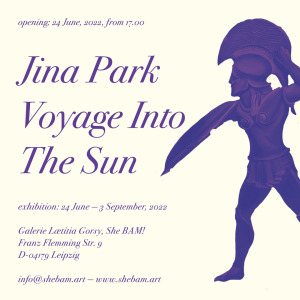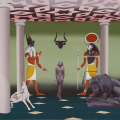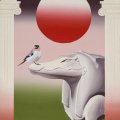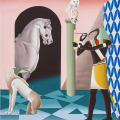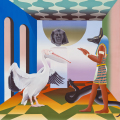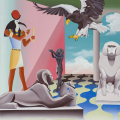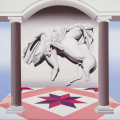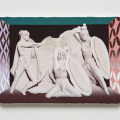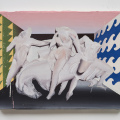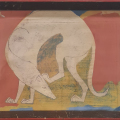Voyage into the Sun 2022
Exhibition: 24 June — 3 September,
2022
Galerie Lætitia Gorsy, She BAM!
Franz Flemming Str. 9
D-04179 Leipzig
+4915901401465
info@shebam.art — www.shebam.art
Jina Park
Voyage into the Sun
Text by Ksenia Jakobson
In Voyage into the Sun, Jina Park traverses the spacetime singularity, capturing the moment of space collapsing, and time folding upon itself. General relativity predicts that any object collapsing beyond a certain point would form a black hole, inside which a singularity would be formed. (1) Likewise, Park’s surreal singularity exists beyond the regular spacetime, it cannot be determined by “when” and “where”, yet it is not zero-dimensional, it still exists in Euclidean space.
Park’s previous works have explored the dream-like realm of collapsing time with its non-linear perspective. In The Moon Palace (2021) the delicate balance of movement and stillness, of flatness and depth creates a space that is at once physical and conceptual, virtual yet real. Suspended in a state of in-betweenness the objects and figures in Park’s paintings patiently maintain a fragile equilibrium. Voyage into the Sun builds upon that inquiry by adding yet another aspect to Park’s surrealist dreamscape. This time, enhancing it with elements of Egyptian iconography, in particular, by introducing aspective.
The concept of “aspective” was coined by Emma Brunner-Traut in relation to Egyptian art and was first mentioned in the epilogue to Heinrich Schaefer’s “Principal of Egyptian Art”. Expanding on Schaefer's idea of Egyptian art being geradvorstallig (based on frontal images), Brunner-Traut defined aspective art primarily by contrasting it with perspective art, which represents a personal viewpoint from which “the object is seen in the context of mankind’s separation from the inanimate world”. (2) Aspective art doesn’t represent a personal perspective. Rather a universal one – “an Egyptian renders what he is depicting part for part as it really and ideally is, always, everywhere and for everybody”. (3) Thus, in the Egyptian canon, for instance, a square surface is shown as an equal, right-angled quadrilateral. While in Greek or Western tradition the same object is “rendered as it appears to the viewer, an arbitrary individual at a random point in time in a particular spot chosen by him and in whatever lighting”. (4)
The distinction between perspective and aspective approaches to a subject results in a drastically different depiction of it. As if to intensify the sense of simultaneity, Park merges the perspective with aspective, forcing our gaze to oscillate between seeing objects as they appear and seeing them as they are. All that while watching eons converge into oblivion.
1 Curiel, Erik (2021). "Singularities and Black Holes". Stanford Encyclopedia of Philosophy. Metaphysics Research Lab,
Stanford University.
2 Brunner-Traut, Emma (1986). “Epilogue: Aspective” in Principal of Egyptian Art”. Oxford Griffith Institute.
3 Ibid.
4 Ibid.
